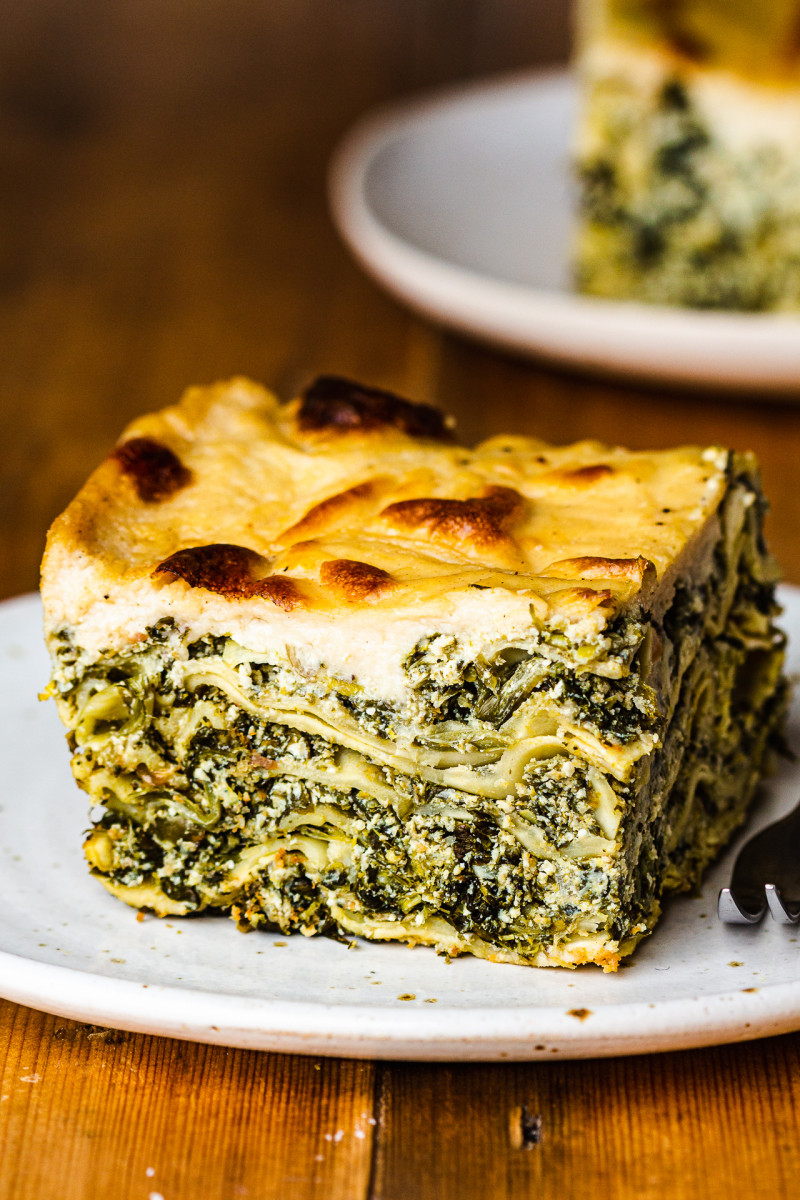
As we’re right in the middle of spinach season here in the UK, I thought it was time for a vegetarian spinach lasagne – a dish that celebrates this dark green vegetable, which was my childhood culinary nemesis. Now that I love spinach and use it often, I recently published my plant-based take on this classic Indian spinach curry – saag paneer – and although its taste and texture reminded me of spinach with garlic cream, I Scared it as a kid, now that I’m ‘Team Spinach’, I love it.
This vegan spinach lasagna is just as delicious, nutritious, and easy to prepare. I made this with frozen spinach because it cuts down the prep time considerably, but you can use fresh spinach if you like. This dish features a spinach sauce flavored with dill, parsley and lemon, layers of perfectly cooked pasta and a generous layer of creamy vegan béchamel, which turns beautifully golden and crisp around the edges. It’s a perfect sharing dish ideal for an upcoming Easter meal or you can make it for one or two and eat it throughout the week – that’s what we do – or freeze the leftovers for another time.
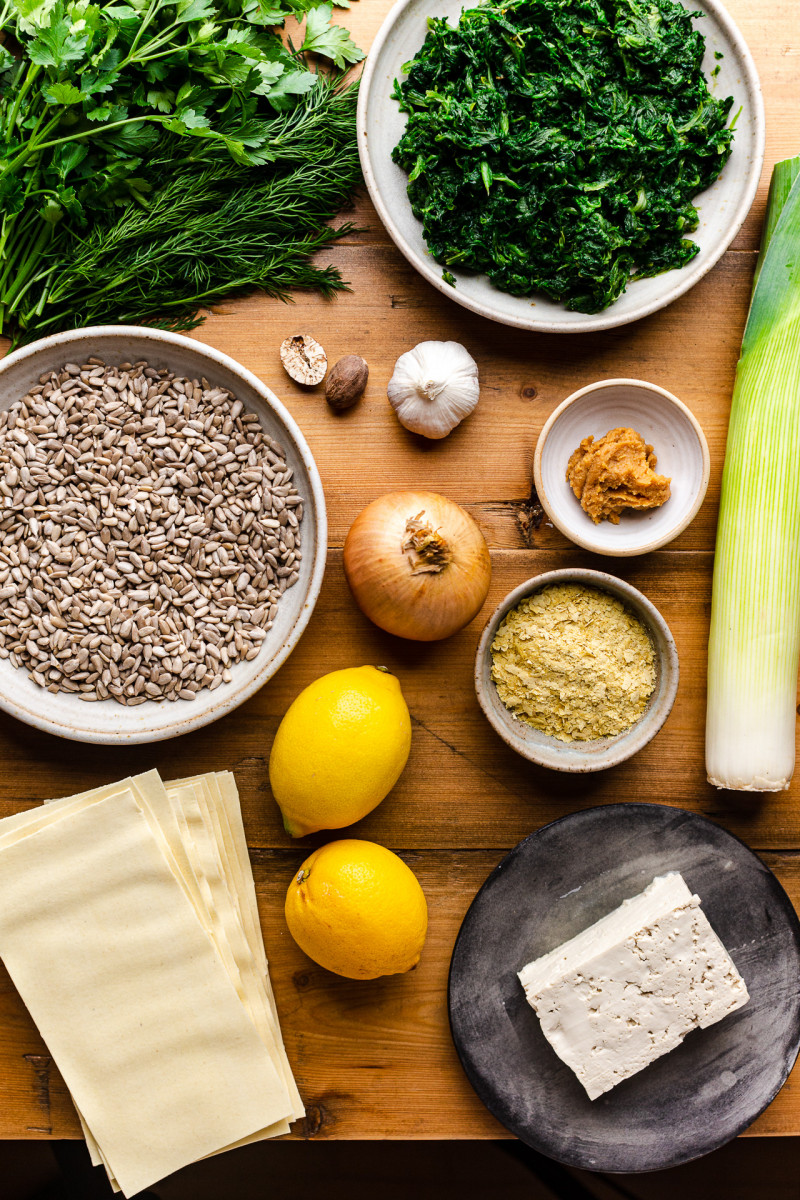
More about ingredients
Spinach: Since it is a spinach, this dish contains a lot of spinach. I used frozen spinach because it cuts down on preparation, but you can use fresh spinach if you have it. I emptied a bag of frozen spinach into a large mixing bowl and let it thaw slowly on my kitchen counter. I then used my hands to squeeze out the moisture before adding it to the pan with the vegan ricotta mixture. If using fresh spinach, use the same amount of spinach by weight, blanch it in boiling water for 60 seconds, drain excess water, then finely chop.
Onion, Garlic: Not much of an explanation is needed here as these are the real staples of any delicacy around the world. Some people add them to the pan at the same time to speed things up, but I prefer to start with the onion because it takes considerably longer to cook than the garlic and there is a risk of the garlic burning if exposed to too much heat, which can make a dish. Go slowly with these two bitter ingredients and be sure to stir often.
Onions: I used a leek alongside the onion, as they are in season now and I enjoy the sweetness of adding it to dishes. The key about leaks is to clean them thoroughly as they are notorious for hiding grit within their layers. I cut off the dark green part and discard, then cut in half lengthwise. When all the layers are nested into each other, I check the grit with my other hand and water if necessary. Dry well before frying.
Sunflower seeds: Hulled sunflower seeds soaked in water to soften are a great plant-based ricotta substitute in this dish. You can also use cashews, but I wanted to keep this dish nut-free and budget-friendly, which sunflower seeds do. Soak them overnight in cold water or boiling water for about 1 hour, drain and they are ready to use.
Tofu: I used sunflower seeds as well as firm (non-silken variety) tofu to mimic the traditionally used ricotta. Do not press the tofu, simply drain and use.
Lemon: I used a zest of two lemons and half a cup of lemon juice to add a touch of brightness and tang to the sauce. Half a cup of lemon juice seems like a lot, but it’s a lot of sauce so don’t be shy and you can always add a little less if your palate is happy.
Nutrition Facts: Nutritional yeast is what adds a hint of cheesiness and umami to both spinach and béchamel. It may seem like a lot, but again it’s a lot of sauce so trust me.
Miso Paste: I used white (shiro) miso paste to add more depth to the spinach sauce. You can use red miso, but be aware that it is more intense so you may want to add a little less.
NUT ME: Nutmeg is an essential spice in such dishes. I used some spinach sauce and bechamel. Ideally, you want to grate it fresh because the flavor is more intense, but an already ground spice works well too. Adjust the amount to taste, if using ground nutmeg you may want to add a little more.
Today: I used a combination of fresh flat leaf parsley and dill in this dish and I like it a lot, but for whatever reason you want to use something different, feel free. Basil would also work well in my opinion.
Lasagna Pasta: Unless it says ‘egg pasta’ on the packet, most lasagna sheets are vegetarian these days, so you should have no problem finding them. They are less hassle as I tend to go for no cooking sheets.
Plant Milk: In addition to using plant milk to make the vegan béchamel, I added a generous amount of plant milk to the spinach sauce to give it the desired consistency.
Olive oil: I use light olive oil as the base for my béchamel sauce, but vegan butter or a mix of the two works well too.
Flour: I use all purpose wheat flour to make a roux for my bechamel. If making this dish gluten-free, use a good gluten-free flour mixture that contains starch and ideally some xanthan gum.
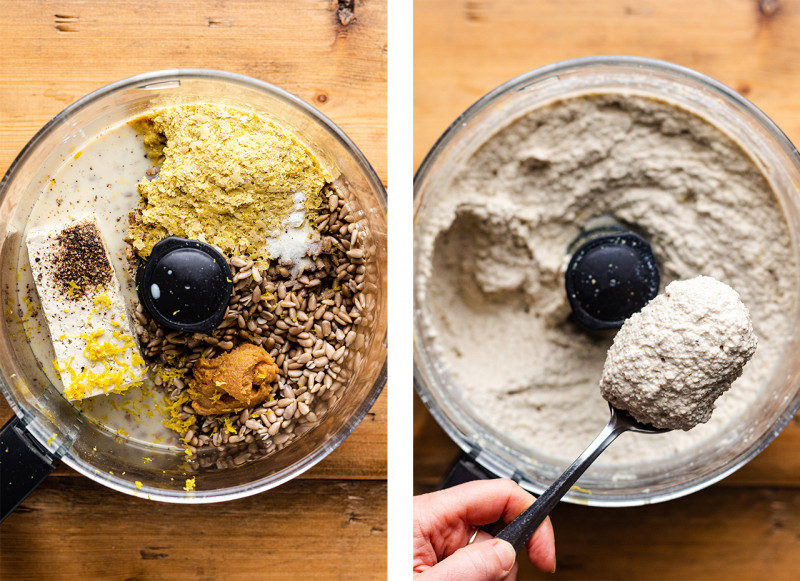
Combine drained (no need to press) tofu and soaked (also drained) sunflower seeds and all flavors in a food processor. Leave some salt and pepper behind so you can adjust the seasoning to your liking at the end. Process trickling in some plant milk until your mixture has a ricotta-like texture (see photo at left).
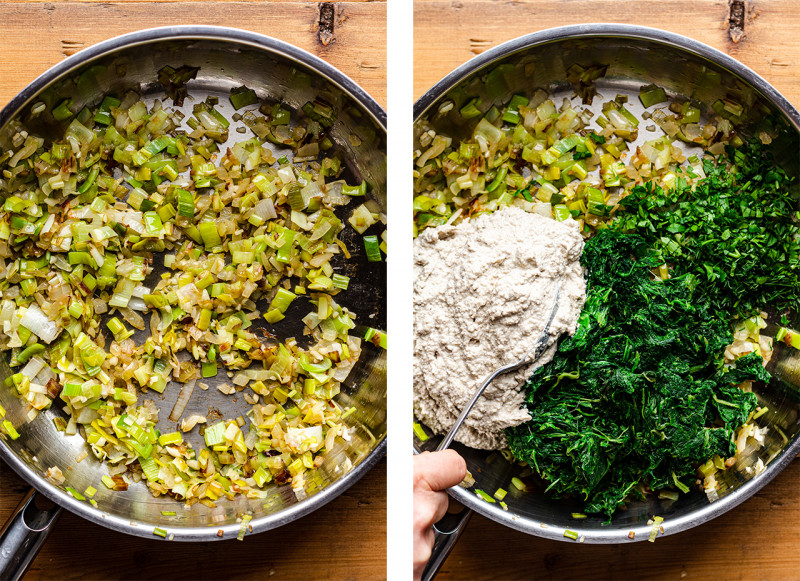
Fry the onion, garlic and leek in some olive oil until soft and translucent. Once done, add the vegan ricotta mixture, toss in the spinach and chopped herbs.
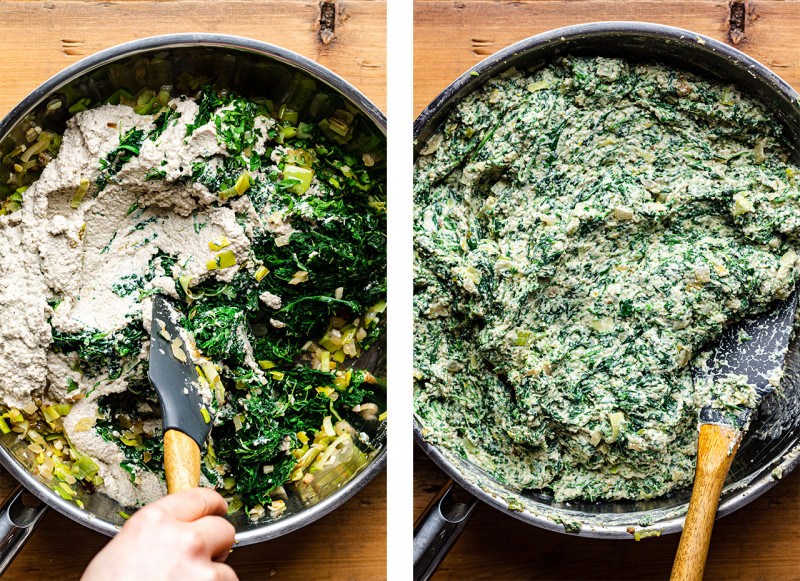
Mix everything together, add the rest of the plant milk to keep this mixture moist and adjust the seasoning to your liking. Remember that pasta is seasonal.
assembly
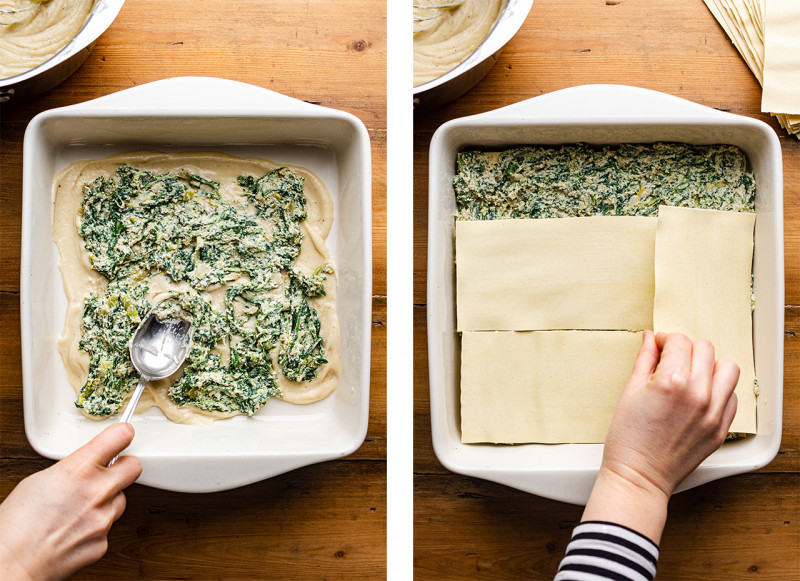
Spread 1/2 cup bechamel sauce and 1/2 cup spinach sauce on the bottom of your baking tray. Cover without pasta sheets – overlap them slightly if necessary and break some with your hands to cover small gaps.
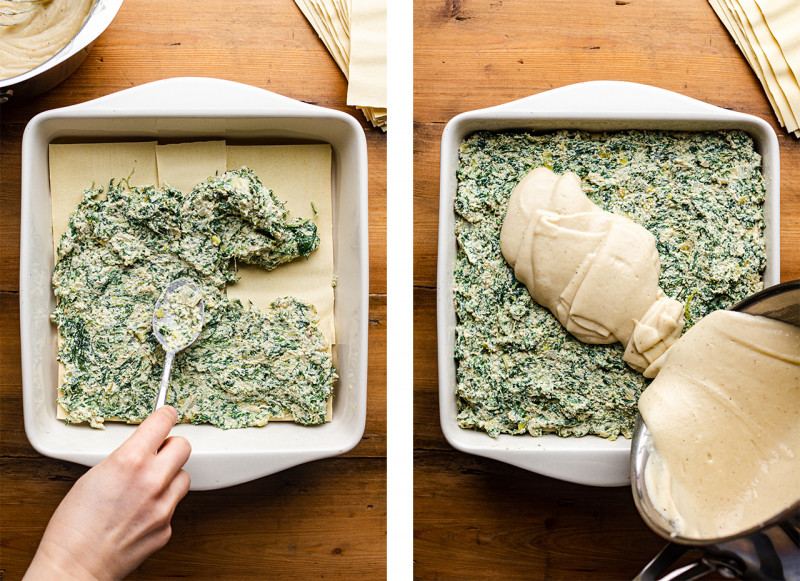
Top the first layer of pasta with about 1.5 cups of the spinach sauce, then another layer of pasta. Repeat the same two more times. Finally spread the rest of the spinach sauce on top and immediately follow with the béchamel. Spread it with a spatula and bake for 40-45 minutes, until the dish is bubbly and the top is golden brown. Allow it to set for an hour before cutting or, better yet, wait until the next day to serve—the flavors of the lasagne will benefit from the extended rest.
Frequently Asked Questions
How long is it kept?
Once cooled, store the lasagna pieces in an air-tight container in the refrigerator for 3-4 days. To reheat, place in an oven-proof dish, cover the top with a piece of kitchen foil and reheat in a 150° C / 300° F oven for about 30 minutes (or until heated through).
Can I freeze it?
Yes, it freezes well. To thaw, refrigerate overnight. To reheat, place in an oven-proof dish, cover the top with a piece of kitchen foil and reheat in a 150° C / 300° F oven for about 30 minutes (or until heated through).
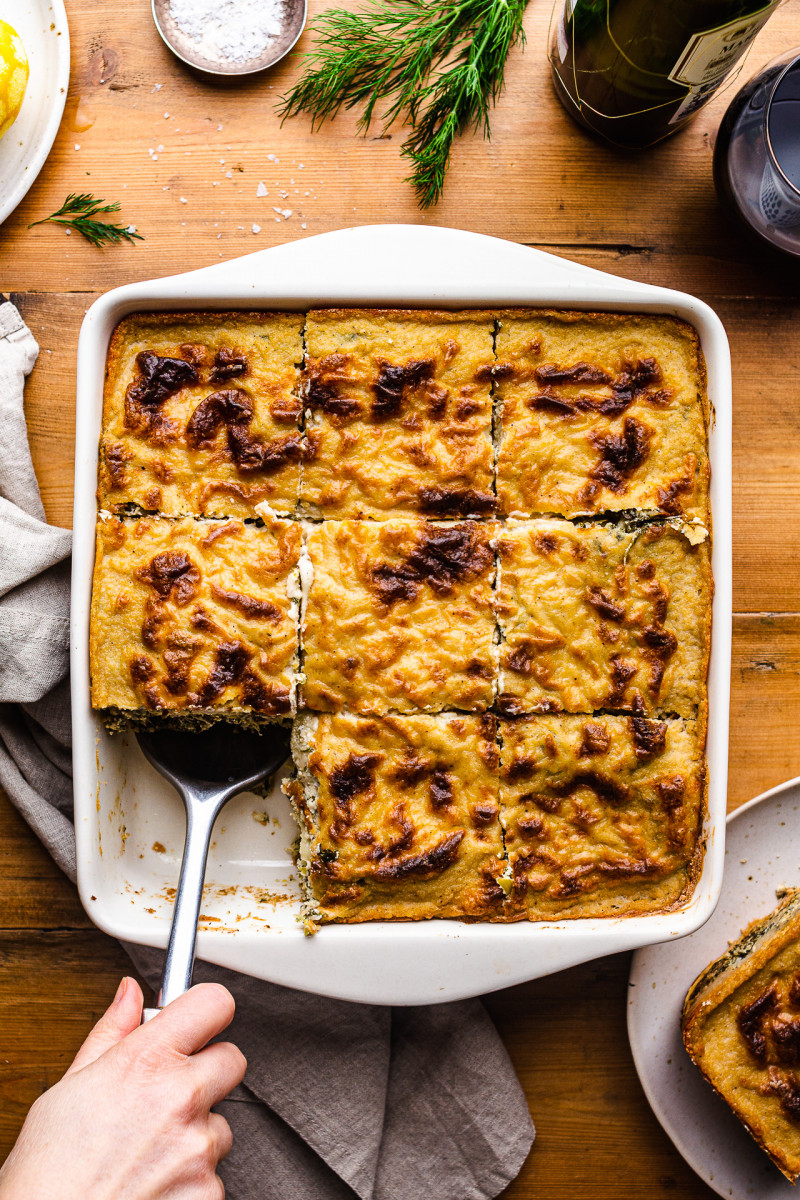
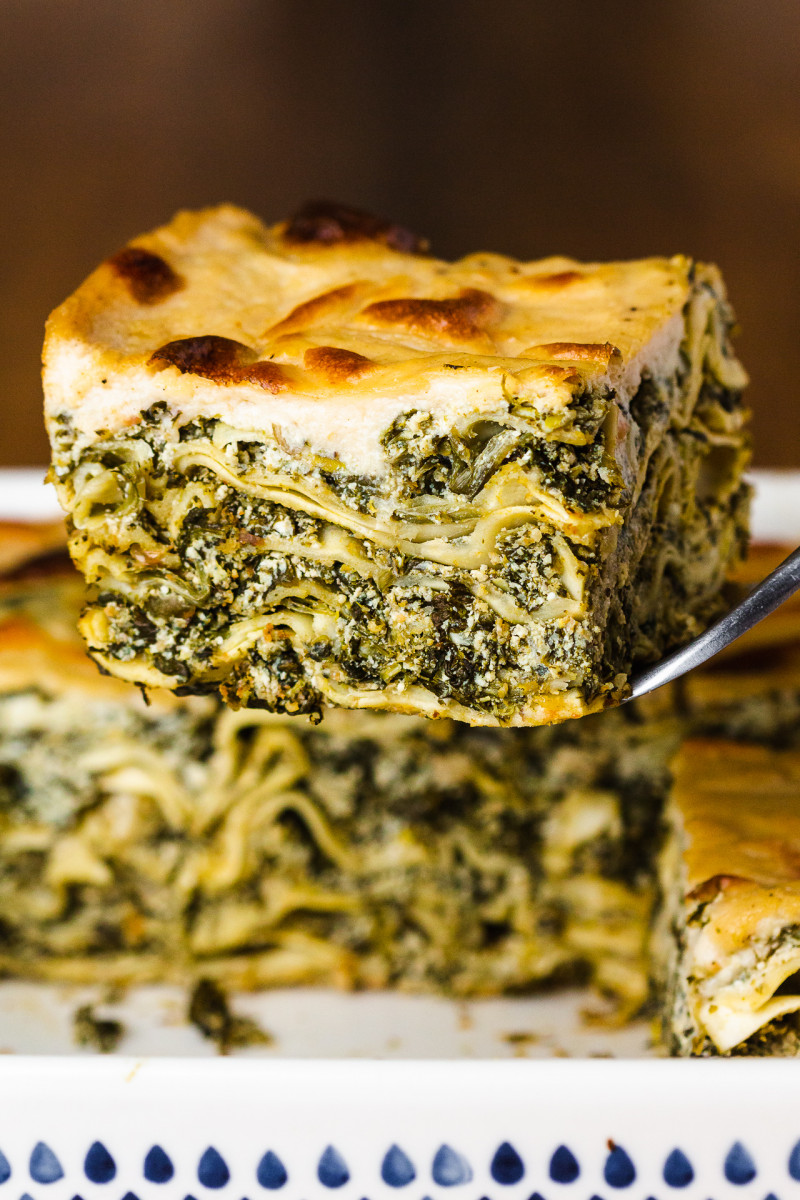
- 1 kg / 35 oz frozen spinach*, defrosted
- 30-60 ml / 2-4 tbsp olive oil
- 1 small onion, finely chopped
- 1 leek (or small onion), finely chopped
- 6 garlic cloves, finely chopped
- 200 g / 1½ cups sunflower seeds* (or cashews), soaked
- 400 g / 14 oz firm unpressed tofu
- 25 g / ½ cup nutritional yeast
- 120 ml / ½ cup lemon juice + zest of 2 lemons
- 30 g / 2 tbsp white miso paste
- 10 grams / 1 tablespoon chopped dill
- 20 g / 2 tbsp chopped parsley
- Half a teaspoon of nutmeg
- 360 ml / 1½ cups soy (or other plant) milk
- ¾ teaspoon black pepper, adjust to taste
- 1¼-½ teaspoon fine salt, adjust to taste
Layer the pasta
- 500 g / 17.5 oz No-Cook Vegan Lasagna Sheets*
Béchamel (or alternative Béchamel)
- 5 g / 1 tsp white miso paste
- 780 ml / 3¼ cups plant milk (I used Otley Barista)
- 80 ml / 1/3 cup light olive oil (or 100 g / 3½ oz vegan butter)
- 80 g/slightly 2/3 cup AP flour (or GF flour blend)
- 3 tablespoons nutritional yeast
- ½ tsp garlic powder (optional)
- salty
- ¼ teaspoon pepper, adjust to taste
- Freshly grated nutmeg to taste (or a little ¼ teaspoon ground)
method
Spinach sauce
- Heat the olive oil (use 2 tbsp for a less spicy version) in a large frying pan, add the chopped onion and fry over a low-medium heat until soft. Add chopped leeks and garlic. Fry until soft.
- Place drained sunflower seeds, unpressed tofu, miso, nutritional yeast, lemon zest, nutmeg, some salt and pepper in a food processor. Process while trickling in the plant milk until the mixture resembles ricotta cheese.
- Add the sunflower tofu mixture, spinach, and herbs to the pan with the sautéed spices. Stir well to combine, add lemon juice (you can adjust the amount to taste) and remaining plant milk and adjust seasoning to taste. The mixture will be quite loose/wet when done.
Béchamel
- Warm plant milk in a small saucepan. Place the miso in a small bowl and add a few tablespoons of milk from the saucepan, stir until it dissolves, set aside.
- Slowly heat the olive oil in a large saucepan (stainless steel works best for this). Once the oil starts to shimmer, sprinkle the flour while shaking the entire tin.
- Allow the fat-flour mixture (known as a roux) to bubble gently over low-medium heat for one minute, whisking the entire time. Don’t let it brown.
- Remove the pot from the heat and slowly pour in the warm plant milk, whisking the entire time. The mixture may seem a little runny at first – don’t worry, it will recover once all the milk is poured in. When the mixture looks stable and smooth, whisk in the miso and nutritional yeast and garlic powder (if using).
- Return the pot to the oven. Simmer briefly (while whisking) until the sauce thickens to the consistency of cream. Season with salt, pepper and nutmeg to taste.
assembly
- Preheat the oven to 180° C / 390° F (or 20° C / 70° F lower with fan).
- Place ½ cup béchamel sauce and ½ cup spinach sauce in the bottom of your baking dish. Follow this with a layer of lasagne sheets.
- Spread 1½ cups spinach sauce on top and cover with another layer of pasta. Repeat the same two layers two more times.
- Finally spread the rest of the spinach over the last pasta layer and then top with all the béchamel sauce. Spread it evenly with a spatula.
- Cover the dish with a piece of kitchen foil and bake for 30 minutes.
- Increase the oven temperature to 220°C / 430°F, uncover the dish and bake for a final 10-15 minutes until the top is golden brown.
- Let the dish set for at least an hour or the slices will come out mushy. Store leftovers in the refrigerator for up to 5 days or freeze in an air-tight container.
Comment
*Tofu: I used UK brand Cauldron’s plain tofu and I didn’t press it for this application.
*Sunflower seeds: I soaked sunflower seeds overnight in cold water, but if you want to speed things up, you can soak them in boiling water for about 1 hour. Cashews can be used instead of sunflower seeds.
* Gluten-free version: If you want to make this dish gluten-free, look for gluten-free pasta sheets and a gluten-free miso based on something other than wheat (rice, chickpeas, millet, etc.). To make béchamel, use a gluten-free flour mixture with starch and xanthan gum.
*Baking dish size: I used a square 25 cm / 10 inch dish that is 5 cm / 2 inches long, a rectangular 33 cm / 13 inch by 22.5 cm / 9 inch dish also works well.
Nutritional information
*1 in every 12 parts

